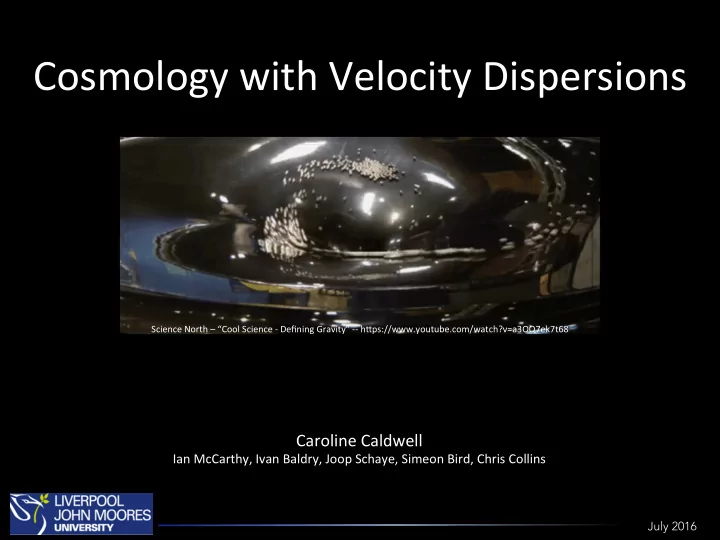

Cosmology with Velocity Dispersions Science North – “Cool Science - Defining Gravity” -- h>ps://www.youtube.com/watch?v=a3OQ7ek7t68 Caroline Caldwell Ian McCarthy, Ivan Baldry, Joop Schaye, Simeon Bird, Chris Collins July 2016
RosaT et al. 2002 Lambda CDM Abundance of clusters, n(z), is a good probe of underlying cosmology. Velocity Dispersions However, there is tension between are directly measured abundances from models based on and avoid mass biases. CMB measurements and observa.ons Good independent test of cluster abundances (number of results! counts). e.g. Planck paper 20, (2013) Einstein-DeSi2er New simulaTons with PotenTal causes of discrepancy: neutrinos + velocity • SystemaTc mass biases dispersion based n(z) • Something is wrong with the can disTnguish effects standard model (neutrinos?) of neutrinos! Caroline Caldwell July 2016
SimulaTon & Survey BAHAMAS: BAryons and HAloes of MAssive Systems Large box (400 Mpc/h, 1024^3 • parTcles) Planck, WMAP9, and cosmologies • +neutrinos Calibrated to match f gas -M properTes • and galaxy stellar mass funcTon Matches X-ray and SZ scaling relaTons • and others. Details: McCarthy et al, 2016 • Credit: Rob Crain / EAGLE simulaTon Caroline Caldwell July 2016
BAHAMAS results The Velocity Dispersion funcTon Number of Groups > 300 km/s Galaxy groups: • At least 4 members • M200m > 10 10 M sun Caroline Caldwell July 2016
Model the VDF Mass FuncTon -> Mean sigma-M powerlaw -> sca>er = “Model” velocity dispersions 1. Mean Mass – velocity dispersion power law. 2. QuanTfy sca>er around powerlaw Black sca>er points = Planck data from simulaTon Red = mean sigma in bins of Mass Yellow = fit to red points Blue = mean and 1- sigma distribuTon of sca>er points Caroline Caldwell July 2016
Sca>er 1. Divide velocity dispersions by the power-law. 2. Bin residuals by mass 3. Fit log normal curve 4. Width of curve = width of sca>er around powerlaw Caroline Caldwell July 2016
Sca>er Sca>er DecomposiTon: Caroline Caldwell July 2016
Parametric Model vs. BAHAMAS Mass FuncTon -> Mean sigma-M powerlaw -> sca>er = “Model” velocity dispersions VDF and dN(z) can be modeled to high precision! Caroline Caldwell July 2016
CreaTng the Ω m σ 8 grid Choose cosmological parameters CAMB Tinker Mass FuncTon (with neutrinos) Convert to VDF Compute number counts Caroline Caldwell July 2016
Constraining Power of Future Surveys Using simulated data only: 1-sigma chi^2 intervals for three survey volumes. σ 8 = normalizaton of power GAMA-like spectrum WAVES-like DESI-like Ω m =density of ma>er Caroline Caldwell July 2016
Constraining Power of Future Surveys Using simulated data only: GAMA-like WAVES-like DESI-like Caroline Caldwell July 2016
Summary • Velocity dispersions can be used for group number counts • Directly observable – alternaTve to mass • Demonstrated that neutrinos can reduce abundances of massive groups • Successfully modeled the VDF • EsTmated confidence intervals for Ω m and σ 8 and neutrino mass arXiv:1602.00611 Future: • Use data from GAMA survey to obtain real confidence intervals Caroline Caldwell July 2016
Recommend
More recommend